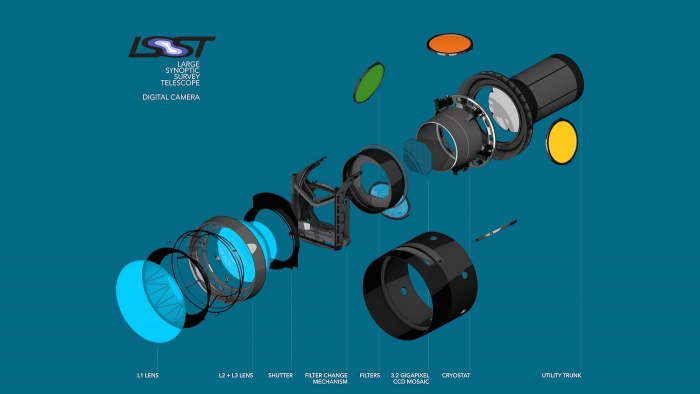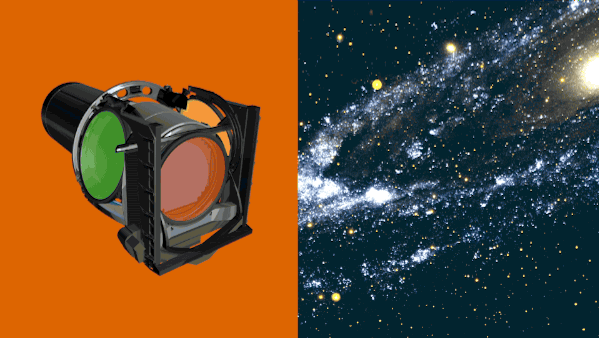In the United States, they are starting a project to create a 3.2 GP digital camera — the Large Viewing Telescope

The US Department of Energy approved a project to create the world's most advanced digital camera with a matrix of 3.2 Gp. This camera will be the “eye” of the Large Synoptic Survey Telescope telescope (large viewing telescope). The scientists and engineers from the SLAC National Accelerator Laboratory will create the camera. The telescope is designed for observing deep space, with photographing the most interesting objects. Perhaps it is this telescope that will be able to help scientists solve some of the most important questions regarding the evolution of the Universe and its individual objects that are on the agenda.
Now experts can begin the development and creation of individual elements of the camera, and also proceed to the creation of the telescope camera itself, after manufacturing the main components. According to the plan, the telescope should be ready by 2020, when this tool can already be used. The telescope will be located at the El Penon peak of the Sero-Pachon mountain (2,682 m) in the Coquimbo area in northern Chile, next to the existing Gemini observatories and the Southern Astrophysical Research Telescope. The system will monitor various parts of the night sky, capturing and cataloging the detected objects. For 10 years, this telescope, as scientists believe, will be able to detect tens of billions of new objects, including billions of galaxies - more than people on Earth.
The main tasks that the telescope will perform are the following:
- Measuring weak gravitational lensing in deep space, in order to detect signs of dark energy and dark matter;
- Mapping and cataloging small objects in the solar system, including Kuiper belt objects;
- Detection of new and supernova stars and observation of them;
- Mapping the Milky Way.
')
According to experts, overnight the telescope will generate up to 30 terabytes of data. A large amount of information will be laid out on the Internet, forming an interactive map of the starry sky.
Also, experts will create animated videos of the night sky for further study of the material obtained.
It should be noted that the size of the camera will be approximately equal to the size of a small car, and the weight will be about three tons. At the same time, the LSST architecture is unique among large telescopes (with an 8-meter mirror) and is made according to the Paul-Baker three-element scheme. This design is able to provide a very wide field of view: its diameter is 3.5 degrees, and its area is 9.6 square degrees. For comparison: the Sun and the Moon, visible from the Earth, have a diameter of 0.5 degrees, and the area is 0.2 square degrees. Combined with a large aperture (and, thus, a better ability to collect light), this will give an incredibly large coverage.
To achieve such a very wide, undistorted field of view, three mirrors are required instead of two used by most existing large telescopes. The main mirror has a diameter of 8.4 meters, the second mirror is 3.4 meters, and the diameter of the third mirror, located behind a large hole in the main mirror, is 5 meters. A large hole reduces the area of collection of the light of the main mirror to 35 m², which is equivalent to the diameter of a one-piece mirror of 6.68 meters. The main and third mirrors are created as a single piece of glass, “M1M3 monolith”.

A digital camera with a matrix of 3.2 gigapixels (consisting of 189 light-sensitive CCD sensors operating in the ultraviolet, visible, and infrared light) will make 15-second exposures every 20 seconds. Taking into account maintenance, bad weather, etc., the camera is supposed to take about 200,000 photos (1.28 petabytes uncompressed) per year, which is much more than people can learn. Therefore, managing and efficiently mining a huge amount of data at the telescope output is expected to be the most technically challenging part of the project. The initial requirements for the computing center are estimated at 100 teraflops of computing power and 15 petabytes for data storage with an increase as new information is received.
The main elements of the camera are created by a number of international organizations that cooperate with each other. Creating a camera and testing it will take about five years.
In addition to the hardware, a software program is being created - in particular, a project to create a telescope database management system is being implemented in parallel. This is also an important element of the project, since a telescope will generate about 6 million gigabytes of data per year. All these data will help specialists to study the formation of galaxies, the structural features of galaxies, track asteroids that are potentially dangerous to the Earth, and perform all other tasks.
Source: https://habr.com/ru/post/368115/
All Articles